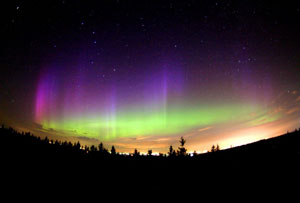Solar Wind
As with all stars, the Sun loses material by way of a stellar wind. Stellar winds are fast moving flows of material (protons, electrons and atoms of heavier metals) that are ejected from stars. These winds are characterised by a continuous outflow of material moving at speeds anywhere between 20 and 2,000 km/sec. In the case of the Sun, the wind ‘blows’ at a speed of 200 to 300 km/sec from quiet regions, and 700 km/sec from coronal holes and active regions.
The causes, ejection rates and speeds of stellar winds vary with the mass of the star. In relatively cool, low-mass stars such as the Sun, the wind is caused by the extremely high temperature (millions of degrees Kelvin) of the corona. This high temperature is thought to be the result of interactions between magnetic fields at the star’s surface, and gives the coronal gas sufficient energy to escape the gravitational attraction of the star as a wind. Stars of this type eject only a tiny fraction of their mass per year as a stellar wind (for example, only 1 part in 1014 of the Sun’s mass is ejected in this way each year), but this still represents losses of millions of tonnes of material each second. Even over their entire lifetime, stars like our Sun lose only a tiny fraction of 1% of their mass through stellar winds.
| The solar wind causes many phenemena when it interacts with the Earth’s upper atmosphere and magnetic field, the most visible of which are the aurorae (Borealis and Australis). These are produced when solar wind particles accelerated by the Earth’s magnetic field collide with atoms and molecules in the upper atmosphere. As the atoms and molecules de-excite, they emit light at specific wavelengths. A similar phenomenon is also seen around the magnetic poles of Jupiter. |
Study Astronomy Online at Swinburne University
All material is © Swinburne University of Technology except where indicated.


